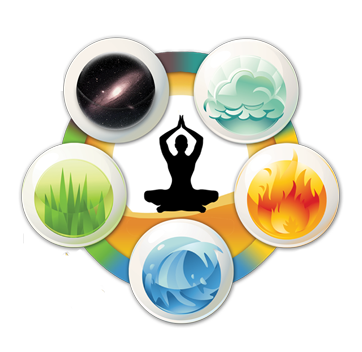Yoga and the Five Great Elements – Is There a Link?
- November 5, 2019
- Posted by: admin
- Category: Featured Content,

By Dr Chandra Nanthakumar
Yoga is an ancient practice that originated in India more than five thousand years ago. This practice primarily deals with the management of the mind. Yoga has evolved through time, hence the many different styles, nevertheless the underlying principles of the mind-body science is still the same.
One of the most common styles practiced by the general population is Patanjali’s Ashtanga Yoga, which consists of the eight limbs of Yga: Yamas (universal conduct), Niyamas (individual conduct), Asanas (postures), Pranayama (expansion of life force), Prathyahara (sense withdrawal), Dharana (concentration), Dhyana (meditation) and Samadhi (liberation). In a classical Hatha Yoga class, almost all these components are practised. The Yamas and Niyamas are often briefly explained and special attention is given to Asanas, Pranayama, Prathyhara, Dharana and Dhyana.
However, in Swatmarama’s teaching, the Yamas and Niyamas are non-existent. They are substituted with Shatkarmas (i.e. cleansing techniques) (Muktibodhananda, 2008). Students are taught these cleansing practices at some point, and subsequently, they are encouraged to practice them at home.
The practice of Yoga (including the shatkarmas), unknown to many practitioners, is deeply linked to the Pancha Mahabhutas, or simply known as the five great elements – earth (Prithvi), water (Jala), fire (Agni), air (Vayu) and space (Akash). Earth is associated with the root Chakra (Muladhara), while water, fire, air and space are linked to the sacrum (Swaddhistana), solar plexus (Manipura), heart (Anahata) and throat (Vishuddi) Chakras, respectively. Scientifically, these five elements are the building blocks of matter, which exists in three different states – solid, liquid and gas (Chang & Overby, 2019). The earth is not merely soil but everything else that exists as solid, while water encompasses everything that is in liquid form. Air, on the other hand, includes everything in a gaseous state. If one goes deeper into science, one will realise that fire is mightier than mighty – it is a prerequisite for the transformation of a solid (for example, ice) to liquid (water) and eventually to air (steam), and withdrawal of fire re-forms the solid.

Space is basically the mother of the four elements. It is the subtlest of all the elements and it is the foundation of spiritual experiences in life (Saraswati, 2007). Space is also the element that represents the mind. Based on the laws of nature, these elements co-exist in the human body and possess a relationship with each other. For instance, if there is too much heat (fire element) in the body, inflammation sets in, but if there is excess water, it dampens the fire element and brings about indigestion. Dis-ease will eventually be the outcome if any of these elements are impure or out of balance with the other.
The practice of Yoga is one of the most effective approaches to not only purify, but also restore balance of these five elements. For example, in the practice of Shatkarmas, specifically Jala Neti (nasal cleansing) and Kunjal (cleansing of the upper digestive track), water is used to remove excessive mucus in the ENT (ear-nose-throat) and esophagus. Kunjal also helps to reduce the excessive digestive acid (fire element) in the stomach.

On the other hand, the fire element is a powerful detoxifier as it has the ability to eradicate impurities in the body and mind. Dynamic Asanas such as Matsyendrasana (seated spinal twist) and Paschimottanasana (seated forward bend) have the ability to increase the digestive fire, which is crucial for toxin removal from the other elements, such as earth, water and air (Muktibodhananda, 2008).
According to Stiles (2010), practising Sun Salutation at a faster pace (i.e. half a cycle should take much less than 60 seconds) is equally effective in balancing the fire and water elements.
It is noteworthy that the most powerful indicator of the functioning of the fire element is in the functioning of the digestive system, which includes proper digestion, absorption of food and also elimination of fecal matter (Mohan & Mohan, 2004).
On the contrary, stationary poses tend to be more cooling and stabilising in nature, thus reducing the metabolic fire. Hence, it is essential for the Yoga instructor to plan the class appropriately to ensure that the selection of Asanas is balanced between dynamic and stationary variations. This allows the fire element to be regulated, while the earth and air elements are harmonised.

Air is another element that can be utilised effectively to cleanse the body of toxins. The practice of pranayama purifies the body and mind by enhancing circulation of Prana (i.e. the life force) throughout the body. Kapalabhati, for example, cleanses the respiratory system and the nasal passage. Bastrika, on the other hand, increases the digestive fire and eliminates phlegm and diseases of ENT. The practice of Pranayama initiates psychological and physical changes that strengthen willpower and steadiness of mind (Sivananda, 2018). With consistent practice, this eventually leads to lightness (Laghima or weightlessness) and inner power.
The higher limbs, Dharana and Dhyana can help one to explore all the five elements simultaneously. Here’s a simple suggested practice that you may try at your convenience.
- Imagine sitting on the ground (for example a rocky surface) in a comfortable position. As you close your eyes, visualise the “earth” you are sitting on.
- Now focus on the inhalation and exhalation. That is the “air” you are breathing.
- Feel the sun rays shining on the rocks that you are seated on. That is the “fire” heating the rocks.
- As it gets warmer, you may begin to perspire. That is the “water” in the perspiration.
- Eventually, as you go deeper into a meditative state, you shall see the “space” that exists within and all around.

That is how exquisitely the practice of meditation connects one to the five great elements. As Yoga practitioners, I reckon we should take a moment to earnestly observe these Pancha Mahabhutas if we have not done so. As we explore these elements (in and) around us, we will be better able to comprehend the link between them and the body, and soon be able to relate it to the entire universe. The way I see it, one of the best ways to “see” the connection is to start meditating on nature right NOW.
References
- Chang, R. & Overby, J. (2018). Chemistry. New York, NY: McGraw Hill Education.
- Mohan, A.G. & Mohan, I. (2004). Yoga therapy: A guide to the therapeutic use of yoga and ayurveda for health and fitness. Boston, MA: Shambhala.
- Muktibodhananda, S. (2008). Hatha yoga pradipika: Light on hatha yoga, Munger, Bihar: Yoga Publications Trust.
- Saraswati, S.S. (2007). Purifying the Five Elements of Our Being. Retrieved from https://www.yogajournal.com/teach/purifying-the-five-elements-of-our-being
- Stiles, M. (2010). Ayurveda yoga therapy. USA: Lotus press.
- Sivananda, S.S. (2018). The Science of Pranayama. Uttarakhand, Himalayas: The Divine Life Society.
